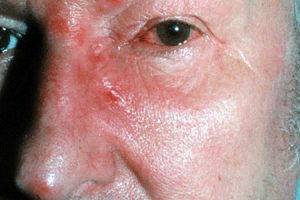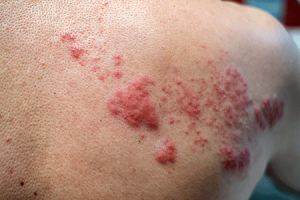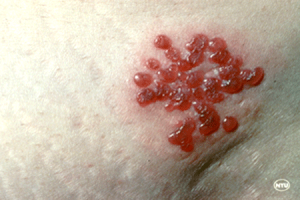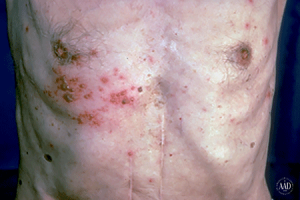Shingles: How to reduce your risk
Shingles: Signs and symptoms
What are the signs and symptoms of shingles?
Shingles causes a painful, blistering rash on your skin. If you get shingles, you may notice the following:
- Before the rash appears: For 1 to 2 days before the rash appears, you may have pain, burning, or tingling on an area of skin where the rash will develop. Some people say they felt an “electrical sensation” on their skin before getting the rash.
- Rash appears: A painful, blistering rash appears. It usually appears on one side of your body, often on the torso; however, it can appear anywhere on your skin. Some people get more blisters after the rash appears, so it can seem that the rash is spreading.
- Rash starts to clear: As the rash clears, the blisters may crack open, bleed, and scab over. For most people, the rash will clear within 2 to 4 weeks.
Although the rash will clear on its own, treatment is important. Taking medication within 3 days of getting the shingles rash can:
- Ease your pain
- Decrease the amount of time you have shingles
- Reduce your risk of developing other health problems, such as long-lasting nerve pain, pneumonia, or hearing loss

Shingles rash on the face
If you have a shingles rash on your face, immediately seeing a doctor for treatment could save your eyesight.
Pictures of the shingles rash
If you have a rash of blisters on your skin or a rash that looks like any shown below, see your doctor immediately for a diagnosis. If you have shingles, it’s important to get treatment, preferably within 2 to 3 days.
If you’ve had the rash for longer than 2 to 3 days, it’s still important to see your doctor.

A typical shingles rash
Doctors often refer to this rash as the “shingles band” because it looks like a band that appears on one area of your body, as shown here.

A rash on one side of the body
A key that you have shingles is that the rash only develops on one side of your body.

Close-up of a shingles rash
The shingles rash often causes a cluster of tiny blisters. You may notice that the skin beneath the blisters is red and inflamed, as shown here.
The rash will also feel painful.

Blistering shingles rash on a man’s chest
Although the rash can begin in one area, you may notice that a few scattered blisters develop in other areas, as shown here.

Shingles rash on the palm of a man’s hand
While shingles tends to develop on your body or face, it can appear anywhere on your skin.
Other signs and symptoms of shingles
Along with a painful, blistering rash, some people can also have one or more of the following:
- Fever
- Headache
- Muscle aches
- Stomach pain
- Vomiting
These tend to go away as the rash clears.
Other health problems due to shingles
Some people develop other health problems after the shingles rash clears, which include:
Postherpetic neuralgia (PHN): This is the most common. Occurring where you had the rash, PHN can cause constant tingling, burning, and pain. For others, the pain comes and goes.
Whether the pain is constant or intermittent, it can go on for a long time. You can have PHN for months, years, or the rest of your life. There is no way to know how long it will last.
The pain caused by PHN can become so severe that it interferes with your life, making everyday activities painful. A musician may no longer be able to play an instrument. Some people cannot walk comfortably. It may be difficult to bathe or get dressed. You may have trouble sleeping.
How to prevent PHN: If you have shingles, you can greatly reduce your risk of PHN by getting treated for shingles within 3 days of developing the rash.

Get treated for shingles within 3 days of developing the rash
Taking antiviral medication within 3 days of getting the shingles rash can:
- Reduce your risk of developing PHN
- Ease symptoms of shingles
- Clear the shingles rash more quickly
Other health problems that can develop after the shingles rash clears include:
- Blindness or loss of some eyesight (if shingles infects your eyes)
- Hearing loss
- Pneumonia
- Encephalitis (swelling of the brain)
- Although rare, some people die of shingles.
Treatment can prevent these complications.
You can find out if you have a greater risk of developing shingles at, Shingles: Causes.
Images
Images 1,4,5,6: Images used with permission of the American Academy of Dermatology National Library of Dermatologic Teaching Slides.
Images 2,3,7: Getty Images
Reference:
Centers for Disease Control and Prevention (CDC). “Prevent Shingles: Get vaccinated.” Page last reviewed July 23, 2018. Last accessed March 28, 2019.
Dooling KL, Guo A, et al. “Recommendations of the Advisory Committee on Immunization Practices for Use of Herpes Zoster Vaccines.” Morb Mortal Wkly Rep 2018;67:103-8.
Madkan V, Sra K, et al. “Human herpes viruses.” In: Bolognia JL, et al. Dermatology. (second edition). Mosby Elsevier, Spain, 2008:1204-8.
Straus SE, Oxman MN, et al. “Varicella and herpes zoster.” In: Wolff K, Goldsmith LA, et al. Fitzpatrick’s Dermatology in General Medicine (seventh edition). McGraw Hill Medical, New York, 2008: 1885-98.
Yang Q. George MG, et al. “Abstract 39: Effect of herpes zoster vaccination and antiviral treatment on risk of ischemic stroke among older adults.” Presented at: 2019 International Stroke Conference. February 6-8, 2019; Honolulu, HI.
© 2024 American Academy of Dermatology. All rights reserved. Reproduction or republication strictly prohibited without prior written permission. Use of these materials is subject to the legal notice and terms of use located at https://www.aad.org/about/legal
